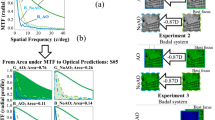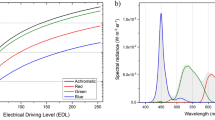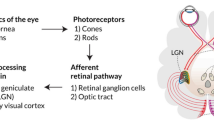Abstract
IF a pattern consisting of blue and yellow areas be viewed at a sufficient distance by an observer, then, in certain circumstances, the blue is seen as black and the yellow is seen as white, so that the pattern appears to be a black and white one. Factors of importance in determining whether the pattern is seen as blue and yellow or as black and white have been found to be (1) the size of the pattern, (2) the intensity of illumination, (3) the size of the pupil, (4) the exact colours of the yellow and the blue pigments used in the design, (5) the adaptation of the retina, (6) spectral content of illuminant. It is suspected that factors of importance would also be (7) absorption of the eye media, and (8) absorption by the macula lutea.
This is a preview of subscription content, access via your institution
Access options
Subscribe to this journal
Receive 51 print issues and online access
$199.00 per year
only $3.90 per issue
Buy this article
- Purchase on Springer Link
- Instant access to full article PDF
Prices may be subject to local taxes which are calculated during checkout
Similar content being viewed by others
Author information
Authors and Affiliations
Rights and permissions
About this article
Cite this article
HARTRIDGE, H. Visibility of Blue and Yellow. Nature 153, 775–776 (1944). https://doi.org/10.1038/153775a0
Issue Date:
DOI: https://doi.org/10.1038/153775a0
This article is cited by
Comments
By submitting a comment you agree to abide by our Terms and Community Guidelines. If you find something abusive or that does not comply with our terms or guidelines please flag it as inappropriate.



